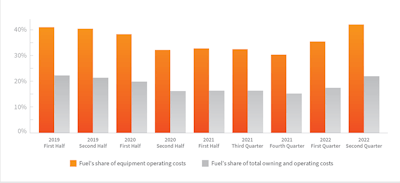
This is Part 1 of a four-part series on managing fuel costs as part of the Fuel Cost Volatility Survival Guide. (Read Part 1, Part 2, Part 3, and Part 4 or download the entire guide.)

Download the Fuel Cost Volatility Survival Guide
→ Ninety-eight percent of construction equipment runs on diesel.
→ The price of diesel has increased 74 percent over the past 12 months and shows no signs of dropping.
→ Fuel accounts for more than 40 percent of machine operating costs – more than repair, parts, and labor.
Yet for most contractors, managing fuel is an afterthought. But with prices for construction materials and services increasing nearly 21 percent over last year, taking a hard look at costs – including fuel – is a matter of survival.
The good news is there are steps contractors can take to manage fuel costs. This guide outlines the current situation, looks at what’s driving fuel volatility (it might not be what you think), offers real-world ideas to help you manage today’s challenges, and gives you tools to maximize efficiency and profitability for years to come.
You can read it in the headlines and see it on your bottom line: The construction economy has been turned upside down. First, supply chain restraints put major pressure on sourcing construction equipment – both new and more recently used channels. Then, supply chain challenges and other economic factors led to shortages of materials, parts, and labor, driving up those costs, too. Massive increases in fuel prices are just the latest headache.
To illustrate, the producer price index for inputs to new non-residential construction rose 20.9 percent over the past 12 months. At the same time, an index that tracks what contractors say they would charge to erect five types of nonresidential buildings rose 19.9 percent. The cost index has risen more than the bid-price index on a year-over-year basis for 19 straight months, notes Ken Simonson, Associated General Contractors' chief economist. And let’s not forget labor. Worker pay jumped 6.3 percent in May from the prior year, the largest increase in 40 years.
On top of all those rising costs, fuel prices have increased 74 percent over the last 12 months. Fuel currently comprises nearly 42 percent of your machine operating costs according to an analysis by EquipmentWatch, owned by Equipment World's parent company, Randall Reilly. (Other operating costs include field labor and parts, lube, and track or tire wear and tear.) On-highway diesel fuel hit an all-time record on June 6, jumping to an average of $5.81 per gallon, $2.59 higher than one year ago.
How the price of fuel affects your operating costs
 Fuel currently makes up more than 40 percent of your equipment operating costs and nearly 22 percent of your total owning and operating costs, according to an analysis of EquipmentWatch data.
Fuel currently makes up more than 40 percent of your equipment operating costs and nearly 22 percent of your total owning and operating costs, according to an analysis of EquipmentWatch data.
Such fuel cost volatility especially impacts contractors with large projects already in motion. These bids were approved months, sometimes years ago, and in many cases, there is no recourse for recouping the unexpected added fuel costs.
With profit margins hovering around 3 percent for heavy civil projects, such discrepancies between what contractors pay versus what they can charge are not sustainable, says Nick Holsinger, EquipmentWatch Strategic Account Manager.
Sky high diesel
 The price of diesel fuel was $2.40/gallon two years ago and started increasing in March of last year. Then in March of this year prices shot straight up for 2 weeks (due in part to Russia’s war in Ukraine and the response via sanctions, according to GasBuddy), before leveling off briefly and then beginning another steep climb.
The price of diesel fuel was $2.40/gallon two years ago and started increasing in March of last year. Then in March of this year prices shot straight up for 2 weeks (due in part to Russia’s war in Ukraine and the response via sanctions, according to GasBuddy), before leveling off briefly and then beginning another steep climb.
And the situation is likely to get worse. While the construction industry celebrated the passage of the $1.2 trillion infrastructure package last November, most of that money has yet to be spent. With too many dollars already chasing too few goods and driving up inflation, what will happen when 50 states and countless municipalities all start projects and try to buy materials, hire workers, and fuel equipment?
Where you operate matters
 It’s no surprise that the highest diesel prices are in the Sunshine State, where a gallon will set you back $6.83, $2.76 cents higher than one year ago. On the opposite coast, New England and the Central Atlantic states have also cracked the $6 mark at $6.19 cents per gallon, nearly $3 higher than last year. The lowest prices are on the Gulf Coast, where a gallon goes for $5.30. One of the main drivers of the price difference? Taxes, of course. On top of the federal diesel fuel tax of .24 cents per gallon, Californians pay .92 cents, second only to Pennsylvania, at .99 cents.
It’s no surprise that the highest diesel prices are in the Sunshine State, where a gallon will set you back $6.83, $2.76 cents higher than one year ago. On the opposite coast, New England and the Central Atlantic states have also cracked the $6 mark at $6.19 cents per gallon, nearly $3 higher than last year. The lowest prices are on the Gulf Coast, where a gallon goes for $5.30. One of the main drivers of the price difference? Taxes, of course. On top of the federal diesel fuel tax of .24 cents per gallon, Californians pay .92 cents, second only to Pennsylvania, at .99 cents.









